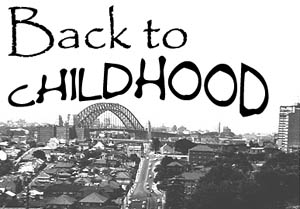 |
Faded photos I still keep. Into the past I often creep To recreate from what I see, The environment that moulded me © Jim Low - "The Passing Years" |
FROM A WINDOW
From 1948 to 1970 I lived with my family in High Street, North Sydney. We lived in a rambling old green and white building called Ulleswater. The Ulleswater estate was divided up and sold at public auction in 1921. A Jewish family purchased the Ulleswater home and converted the building into flats. My father was living in one of these flats when he married my mother in 1943.
My brother and I shared a bedroom. From our bedroom window we looked onto High Street and up to the North Sydney skyline. During the time I lived here the scene from my bedroom window was to change dramatically. This window was to become for us a vantage point from which to observe the dramatic changes that our suburb was undergoing. Immediately in front of the bedroom window was a landing, the top of the entrance stairway to our flat. As I look back over childhood photographs, I realise that this landing was obviously one of my father's favourite spots for taking photos of his boys. The background to many of these family snaps clearly shows the view of High Street and the North Sydney skyline. Besides recording the changes in my brother and me as we grew up, the photographs also inadvertently document the changes to our suburb. |
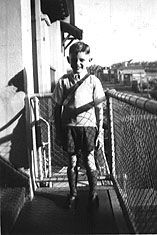 |
THE MLC BUILDING . . .
I believe that growing up in North Sydney in the 1950s and 1960s was in many ways responsible for developing a passion for history in both my brother and me. Concepts of time and change were naturally evolving for us.
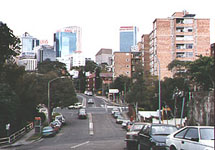 The MLC building, a fourteen-storey office block in Miller Street, was completed in 1957. The construction of a weather beacon on top of it was tantamount to a prophetic claim by the builders that this was about as high as buildings were going to get in the suburb. The beacon could be clearly viewed from afar, its yellow and red lights indicating, not always accurately, the weather predictions for the day. We were given a small card that explained to us the different weather forecasts, depending on the movement and colour of the beacon's lights.
The MLC building, a fourteen-storey office block in Miller Street, was completed in 1957. The construction of a weather beacon on top of it was tantamount to a prophetic claim by the builders that this was about as high as buildings were going to get in the suburb. The beacon could be clearly viewed from afar, its yellow and red lights indicating, not always accurately, the weather predictions for the day. We were given a small card that explained to us the different weather forecasts, depending on the movement and colour of the beacon's lights.
The MLC building imposed its dominance upon the view from my bedroom window. As the beacon lights ascended, descended or flashed, we interpreted each day's weather forecast. For a number of years the MLC building remained unopposed in its rule of the North Sydney skyline. Old timers of the district reinforced this belief with emphatic statements like: "They'll never build anything bigger than that. Not a chance!"
But since then, successful challenges to the building's supremacy have been made on all sides. Today, the MLC building is now dwarfed by a multitude of other constructions straining to reach higher and higher into the sky.
THE WARRINGAH EXPRESSWAY . . .
During my childhood North Sydney was a suburb undergoing major change. The greatest cause of change during this time was the construction of the Warringah Expressway. It changed the residential character of the district forever, literally ripping my suburb in half. Buildings of significance, houses and small businesses were crushed under the metal tread of bulldozers. Nothing was spared if it lay in the pathway of the approaching expressway. While all this destruction was taking place, large office blocks and housing apartments began appearing in the suburb.
THE MORETON BAY FIG . . .
Its size was so big
It taught me there are those
Who don't care a fig.
© Jim Low - "Sixty Long Years"
 I still remember the destruction of a giant sixty year old Moreton Bay Fig Tree which was bulldozed to the ground. I have a photograph I took of the tree which stood at the top of our street. It was destroyed in 1965, the year I started university, being removed to make way for the new expressway. The local newspaper wrote about the tree's demise, entitling their article, "The Death of a Monarch". Sadly, this monarch would have no successor.
I still remember the destruction of a giant sixty year old Moreton Bay Fig Tree which was bulldozed to the ground. I have a photograph I took of the tree which stood at the top of our street. It was destroyed in 1965, the year I started university, being removed to make way for the new expressway. The local newspaper wrote about the tree's demise, entitling their article, "The Death of a Monarch". Sadly, this monarch would have no successor.
The day the tree was killed it rained very heavily. I guess that was appropriate - nature's own way of mourning a significant loss. And it was a sad occasion. The tree's destruction seemed to symbolise for me the realisation that my youth was now over. The tree was the last of many things to go, making way for the expressway.
ORPHEUM THEATRE . . .
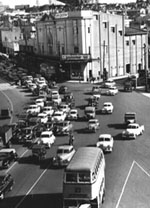 The first building you saw on crossing the Sydney Harbour Bridge to the northern shores of the harbour was the Orpheum Theatre. It had been an imposing landmark on the Pacific Highway. Even the name Orpheum, to a child's ears, suggested strange and wonderful places: new worlds that waited discovery.
The first building you saw on crossing the Sydney Harbour Bridge to the northern shores of the harbour was the Orpheum Theatre. It had been an imposing landmark on the Pacific Highway. Even the name Orpheum, to a child's ears, suggested strange and wonderful places: new worlds that waited discovery.
The OrpheumThe Saturday matinee picture sessions were well attended by the local children. Our stomachs churned with excitement at the exploits of the hero of the serial and our patience was strained by having to wait a week to find out whether he lived to fight another day. We soon discovered that patience was a virtue which many of us lacked. Thank goodness the radio serials of the following week diverted our attention until Saturday returned.
I attended the last film screened at the Orpheum. It was appropriately, "Gone With The Wind". I can still see the colourful streamers that were thrown from the dress circle at the end of the film, a sad memory of the theatre's final curtain call.
EXPRESSWAY VICTIMS . . .
Next to the theatre was a glass-fronted shop in which were displayed coloured pictures from films "coming soon to a theatre near you". I quite often stopped on my way home from school and looked at these. Next to this was the local barber's shop, the inside walls of which were covered with photographs of horse races. You paid your money across a counter crowded with tobacco, cigarette papers and packets of Craven-A. The slogan for this brand of cigarettes was "they never vary". We changed it to "they never very good", unintentionally mocking the new phrasings our young ears were now starting to hear with the increase of immigration to Australia after the Second World War.
Mr Clancy, the barber, would always give my brother and me a packet of chewing gum when we paid for our haircuts. My mother believed that this was his way of handling the embarrassment she believed he must surely have felt for the regular increases in the price of haircuts. I just thought he liked seeing children happy. He and Mrs Clancy had no children of their own.
All these places are now just memories, demolished along with many others. The hotel, newsagency and delicatessen at the top of my street were raised to the ground. Frank Delandro Car yard and Service Station went, the place where my father traded our beloved old Ford, with the 'dicky' seat, for a new second-hand Zephyr Six, like the ones driven in the popular British police television show “Z Cars”.
On the Pacific Highway I can still remember the smell of the oil that used to waft from the garage workshops near the Orpheum and the milk bar next door where we used to go after the picture shows.
We caught the school bus at the top of our street. The bus stop was just in front of an old house occupied by an elderly couple. We called them Ben and Bella. These were not their real names. I think my father affectionately christened them these. You were "safe" if you caught the morning bus before Ben and Bella appeared at their door. I wonder what happened to them? There was a fish and chip shop nearby too. On a cold winter's day, on the way home from school, you made sure your pocket money stretched to a couple of scallops. Many sights, sounds and smells from my childhood fell victim to this new expressway.
DOCUMENTING CHANGE . . .
Echoing the passing years
© Jim Low - "The Passing Years"
Much of the way that I walked to high school each day is now gone forever. This change was seen as synonymous with progress. In 1964, my final year at school, I completed what was then the Leaving Certificate at North Sydney Boys High School on Falcon Street. On one of my final walks to school I took my camera with me and photographed parts of my changing suburb.
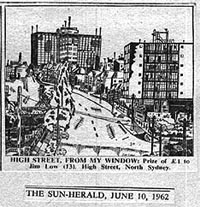 My desire to document change can also be seen in some of the pen and ink drawings I did of my district. Three of these I was fortunate enough to have published in a Sydney weekend newspaper's section for children. One of these is a drawing entitled "High Street, From My Window". It was drawn in 1962 when I was thirteen and published in the Sun-Herald on June 10 of that year. I received a pound for my efforts.
My desire to document change can also be seen in some of the pen and ink drawings I did of my district. Three of these I was fortunate enough to have published in a Sydney weekend newspaper's section for children. One of these is a drawing entitled "High Street, From My Window". It was drawn in 1962 when I was thirteen and published in the Sun-Herald on June 10 of that year. I received a pound for my efforts.
The MLC building, with its beacon, dominates the skyline in my drawing but it is interesting to notice the construction of another office block in front of it. The scaffolding to the left of this new building can be seen. In the right of the drawing is the first stage of the Lelani high-rise living apartments. They were built on the old council site on High Street during the second half of the 1960s. In the bottom right-hand corner is Clark Road. This road was later extended, cutting across High Street and joining McDougall Street, an example of how the Warringah Expressway was to change existing thoroughfares in North Sydney. The North Sydney Post Office clock tower can also be seen just to the left of the MLC building.
PARKS AND GARDENS . . .
She watched new buildings crowd the skies
Office blocks replacing houses
A city growing before her eyes.
© Jim Low - "Miss Carey's Little Park"
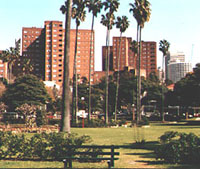 Ulleswater overlooks Milson Park. This park holds many memories. Here we played hide and seek, soldiers, cricket, chasings and the like.
Ulleswater overlooks Milson Park. This park holds many memories. Here we played hide and seek, soldiers, cricket, chasings and the like.
Next to the park is a smaller one, Miss Gladys Carey's Reserve. Miss Carey used to live with her older sister in High Street, North Sydney. This was not far from where my family lived. She had come to Australia from England as a child with her family last century. When I first met her in the 1950's she would have been over seventy years old.
During the Second World War, people living in North Sydney were asked by their local council to look after the appearance of their street. Miss Carey acted upon this request, keeping not only the footpath in front of her home tidy, but other neighbours' home fronts as well. Just opposite Miss Carey's house was a walkway down to Milson Park. Part of this walkway included a steep staircase, beside which there was an area of ground that had been left to run wild. Over the next twenty years Miss Carey changed this area into gardens. At the bottom of the staircase she made a park.
I can still remember Miss Carey quite clearly. Weather didn't stop her gardening and she could be seen toiling away on the most miserable of days. All the plants she grew came from cuttings from her own garden, her neighbours' and even those which people had thrown in the street. The stones that formed the rockeries were manoeuvred into place by her.
When I was a child, bread was delivered to homes in our district by horse and cart. The baker's cart would stop each day opposite Ulleswater where I lived. At my mother's suggestion, I would shovel up the horse manure that was left most days on the side of the road after the baker's visit. With my bucket of hot manure, I would then walk the short distance to Miss Carey's park and leave the contents there. She was a very friendly old lady and most thankful for the manure. I remember once, after she had tended her gardens and rockeries, that she went home and returned with some slides and a viewer. Seating herself in Milson Park, she proceeded to show my friends and me slides of far off places she had visited.
In 1967 the local council recognised the work of Miss Carey by naming this area after her. Whenever I return to North Sydney I try to make time to visit her park and happily spend some time remembering this wonderful old lady who believed in the value of living a useful life.
Nowadays when I return to North Sydney, I deliberately travel the district by foot, the way I did as a child. Walking allows me the opportunity to observe that finer detail noticed as an inquisitive child. I've also found that walking unclutters the mind of a lot of excess baggage the years have thrown on board, allowing my memory to function more effectively.
The experience of roaming this environment, which I knew intimately as a child, is similar to looking at a photograph that's been double-exposed. Layered below the scenes confronting me now are the old images from childhood memory. The people and places from the North Sydney I knew as a child, now appear in the songs and stories I have written, another way of documenting my childhood memories.
LOOKING BACK . . .
Nowadays when I return to North Sydney, I deliberately travel the district by foot, the way I did as a child. Walking allows me the opportunity to observe that finer detail noticed as an inquisitive child. I've also found that walking unclutters the mind of a lot of excess baggage the years have thrown on board, allowing my memory to function more effectively.
The experience of roaming this environment, which I knew intimately as a child, is similar to looking at a photograph that's been double-exposed. Layered below the scenes confronting me now are the old images from childhood memory.
The people and places from the North Sydney I knew as a child, now appear in the songs and stories I have written, another way of documenting my childhood memories.
